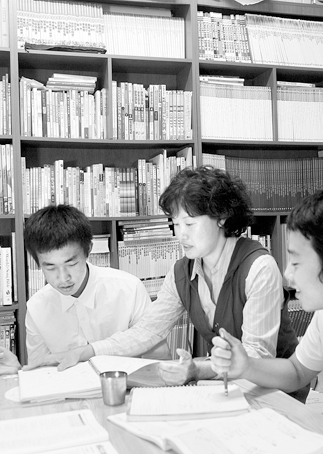A teacher gives poor children free education

Shin is teacher, guardian and counselor to children attending her gongbubang in Haengdang-dong, western Seoul. By Kim Tae-sung
“To raise my son properly, it isn’t enough to focus on just him,” Shin said. “His friends also have to be mentally and physically healthy for my son to grow up correctly.”
Unlike other mothers interested only in their own children’s education, Shin decided in May 2005 to teach students from poor urban areas. She had a stable job then as a teacher at Seoul International School after returning from the United States. She had immigrated to the U.S. in 1996 and lived there for four years after earning a degree in library and information science.
“The environment at the international school was outstanding. Observing the students there, I became curious how lower-income children could do as well.”
Shin went to the ward office near her home with plans to teach students English after she came home from work in the evenings. Right after opening her free gongbubang, she found out that it was not only English they needed. She couldn’t let down the children who came to her classroom. She borrowed money and rented a small room, and registered it at the district office as a children’s center. With a subsidy from the local government, she could expand the operation.
“Even elementary school graduates could not do multiplication. Along with academic issues, they had family problems, which deprived them of self-confidence and dreams.”
She became teacher, guardian and counselor to the children. She taught them not just school subjects but also manners. She conversed with them as if they were her own children. The free classroom became a gathering place for more them 30 children, who came directly from school and stayed until evening.
Shin helped high school dropouts to pass the Korean version of the GED or General Education Development tests. Her own son also passed the GED tests for high school with home schooling.
“I tried to maintain an environment [in the classroom] adequate enough for my own son. I wanted to teach them that they can earn respect if they learned and studied.”
Shin, however, had some worries in recent days. The free classroom needed to move from its 28-square-meter (302-square-foot) room. The government is granting 1.7 won ($1,812) monthly and some donations are coming from sponsors. But costs for textbooks, snacks and wages for the assistant teacher ― 900,000 won ― used up almost all the money coming in.
The Seoul Metropolitan Government recently promised an 80-million-won subsidy to help the hagwon get a new location for its work.
“Everything is difficult, but if there are kids in need, I will have doors open.”
By Kim Eun-ha JoongAng Ilbo [yhwang@joongang.co.kr]










with the Korea JoongAng Daily
To write comments, please log in to one of the accounts.
Standards Board Policy (0/250자)